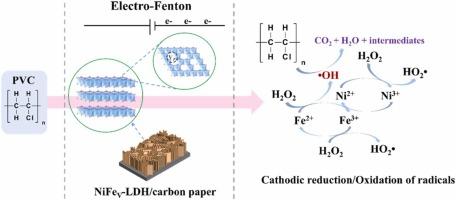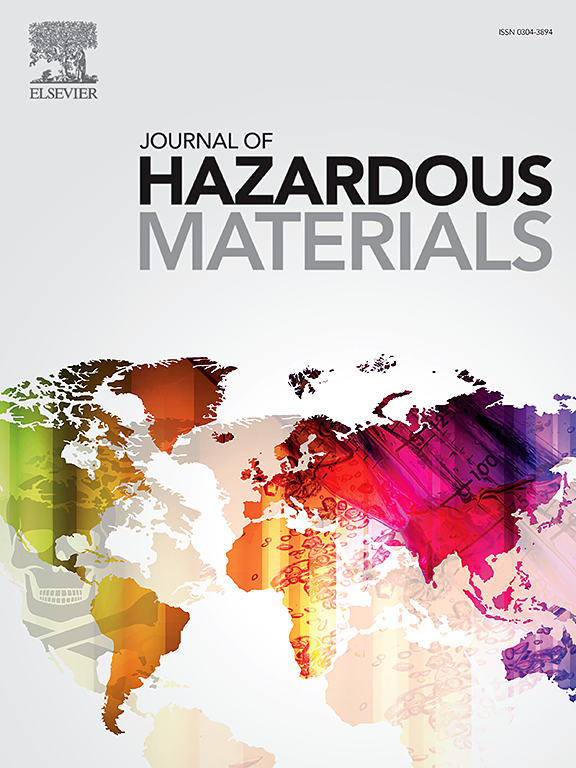Vacancy-rich NiFe-LDH/carbon paper as a novel self-supporting electrode for the electro-Fenton degradation of polyvinyl chloride microplastics
IF 12.2
1区 环境科学与生态学
Q1 ENGINEERING, ENVIRONMENTAL
引用次数: 0
Abstract
Electrochemically upcycling polyvinyl chloride (PVC) into high-value small molecules represents a sustainable strategy for mitigating plastic pollution. Herein, a cost-effective self-supporting electrode with abundant vacancies, i.e., NiFe-layered double hydroxide nanoarrays in-situ grown on the surface of carbon paper (denoted as NiFeV-LDH/CP), is developed for the electro-Fenton degradation of PVC microplastics (MPs). The NiFeV-LDH catalyst shows a high selectivity of 76 % towards H2O2 production via two-electron oxygen reduction reaction (2e- ORR). Density functional theory (DFT) calculations reveal that the energy barrier of rate-determining step (*H2O2 desorption) decreases over the vacancy-enriched NiFeV-LDH related to the pristine NiFeZn-LDH. The influence of vacancy concentration, reaction temperature and initial concentration of PVC MPs were systematically investigated. Under optimized conditions, the NiFeV-LDH/CP electrode exhibits an outstanding degradation performance of PVC MPs via direct cathodic reduction and oxidation by hydroxyl radicals. This work demonstrates that the electro-Fenton technology using LDH-based self-supporting electrodes is a promising and environmentally-friendly approach for waste plastic treatment.

富空位NiFe-LDH/碳纸作为电- fenton降解聚氯乙烯微塑料的新型自支撑电极
电化学法将聚氯乙烯(PVC)升级为高价值的小分子,是减轻塑料污染的可持续策略。本文研究了一种具有丰富空位的低成本自支撑电极,即原位生长在碳纸表面的nife层状双氢氧化物纳米阵列(简称NiFeV-LDH/CP),用于电fenton降解PVC微塑料(MPs)。NiFeV-LDH催化剂对双电子氧还原反应(2e- ORR)生成H2O2的选择性高达76% %。密度泛函理论(DFT)计算表明,与原始NiFeZn-LDH相关的空位富集NiFeV-LDH,决定速率步骤(*H2O2解吸)的能垒降低。系统考察了空位浓度、反应温度和初始浓度对聚氯乙烯MPs的影响。在优化条件下,NiFeV-LDH/CP电极通过直接阴极还原和羟基自由基氧化表现出优异的降解PVC MPs的性能。这项工作表明,使用基于ldh的自支撑电极的电fenton技术是一种有前途的环保废塑料处理方法。
本文章由计算机程序翻译,如有差异,请以英文原文为准。
求助全文
约1分钟内获得全文
求助全文
来源期刊

Journal of Hazardous Materials
工程技术-工程:环境
CiteScore
25.40
自引率
5.90%
发文量
3059
审稿时长
58 days
期刊介绍:
The Journal of Hazardous Materials serves as a global platform for promoting cutting-edge research in the field of Environmental Science and Engineering. Our publication features a wide range of articles, including full-length research papers, review articles, and perspectives, with the aim of enhancing our understanding of the dangers and risks associated with various materials concerning public health and the environment. It is important to note that the term "environmental contaminants" refers specifically to substances that pose hazardous effects through contamination, while excluding those that do not have such impacts on the environment or human health. Moreover, we emphasize the distinction between wastes and hazardous materials in order to provide further clarity on the scope of the journal. We have a keen interest in exploring specific compounds and microbial agents that have adverse effects on the environment.
 求助内容:
求助内容: 应助结果提醒方式:
应助结果提醒方式:


